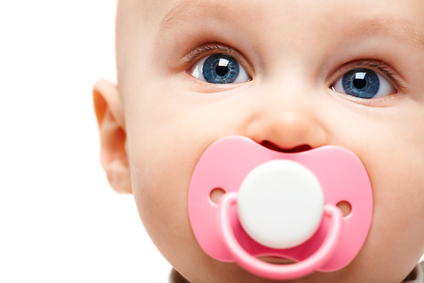
Babies love to suck—literally. While some babies only like to suck during feedings, most babies seek the comfort of the sucking motion all day long by gumming their knuckles, the edge of a blanket, or whatever toy they can nudge toward their mouths. The activity is a natural reflex and it makes babies feel calm and secure.
A pacifier—also called a paci, a binky, a nuk, nubby, or dummy—gives infants something perfectly shaped to suck upon, which is why pacifiers are such a wonderful tool to soothe your infant between feedings.
So what is the safest type of pacifier for infants?
The Anatomy Of A Pacifier
Pacifiers come in two basic constructions: One-piece and multi-piece.
A multi-piece pacifier has a nipple, a guard, and a handle of some sort (often a ring or an easy-to-grip protrusion). The baby sucks on the nipple, the guard prevents the baby from sucking the whole nipple into his mouth, and the handle allows you to pull the pacifier out without having to slide your fingers into the cheek-drool.
Multi-piece pacifiers come in a wide variety of styles, shapes, and colors, including ones with joke mustaches and others whose shields glow in the dark. The latter can be very useful when your infant loses his pacifier in the middle of the night.
One-piece pacifiers come in fewer varieties. They’re molded, seamless, out of one piece of plastic, silicone, latex, or some amalgam of the three.
For both one-piece and multi-piece pacifiers, the nipple is generally made of silicone, which is easy to wash and dishwasher safe. Occasionally, the nipple will be made of latex which is softer on a baby’s tongue, but not dishwasher safe.
Pacifier Safety
Because molded one-piece pacifiers are not made of separate parts, they’re considered the safest pacifiers for infants. Keep in mind, however, that the risk of brand-new, multi-piece pacifiers coming apart is very low.
Whether one-piece or multi-piece, all pacifiers eventually wear out. Make sure to check your infant’s pacifier frequently to make sure there are no holes, tears, or cracks in the nipple. For multi-part pacifiers, give the nipple a good tug to make sure it doesn’t loosen or come free of the guard. Latex nipples tend to wear out faster than silicone ones, so they’ll need to be monitored more closely.
It’s always a smart idea to keep backup versions of your infant’s favorite pacifier on hand, just in case one wears out and you need to do a quick switcheroo.





















